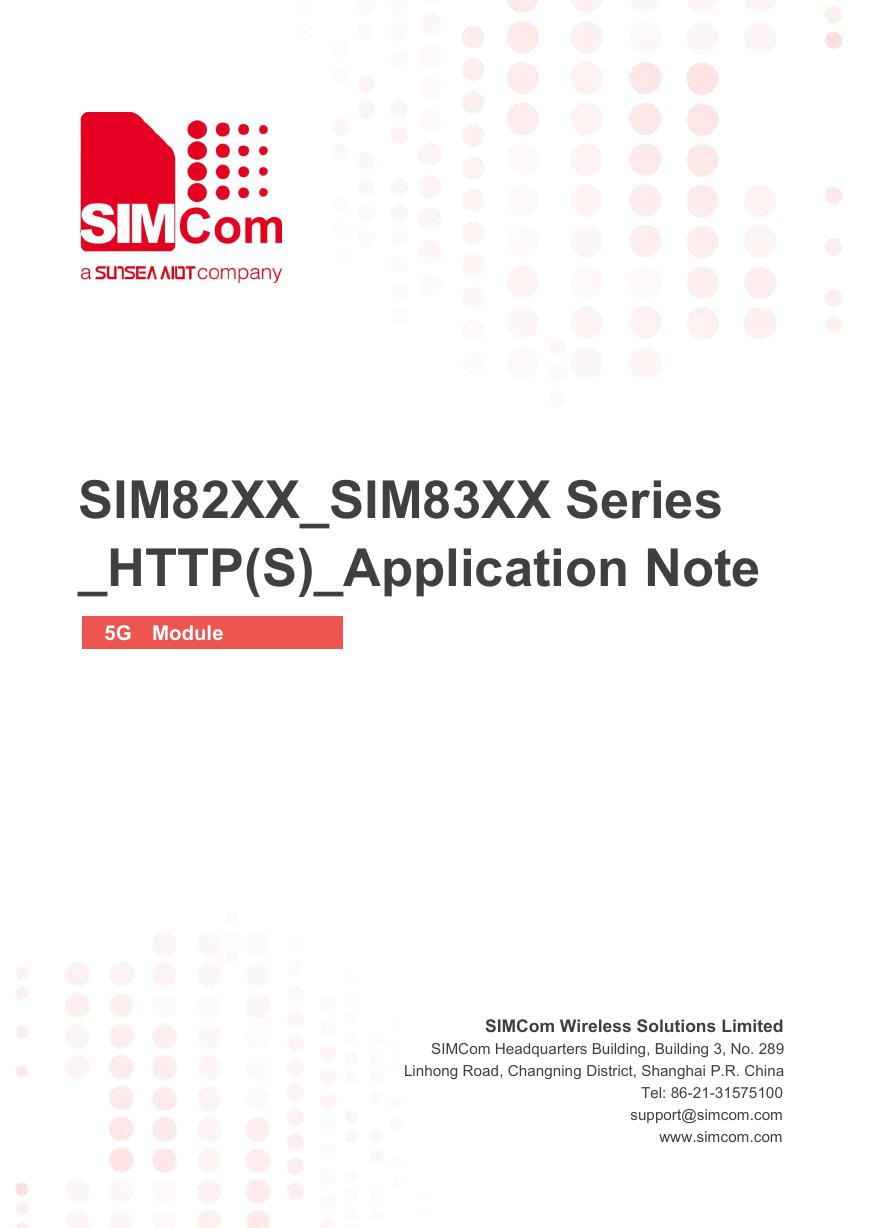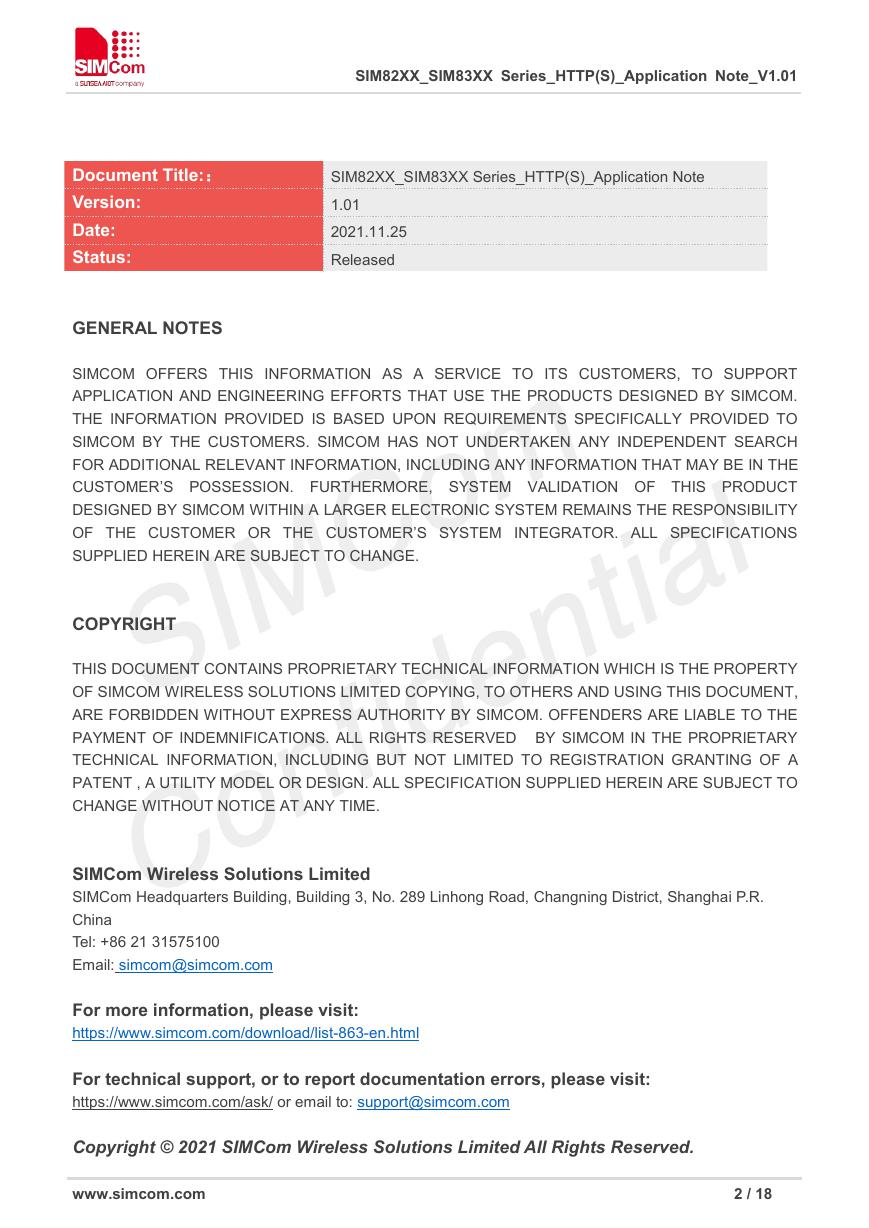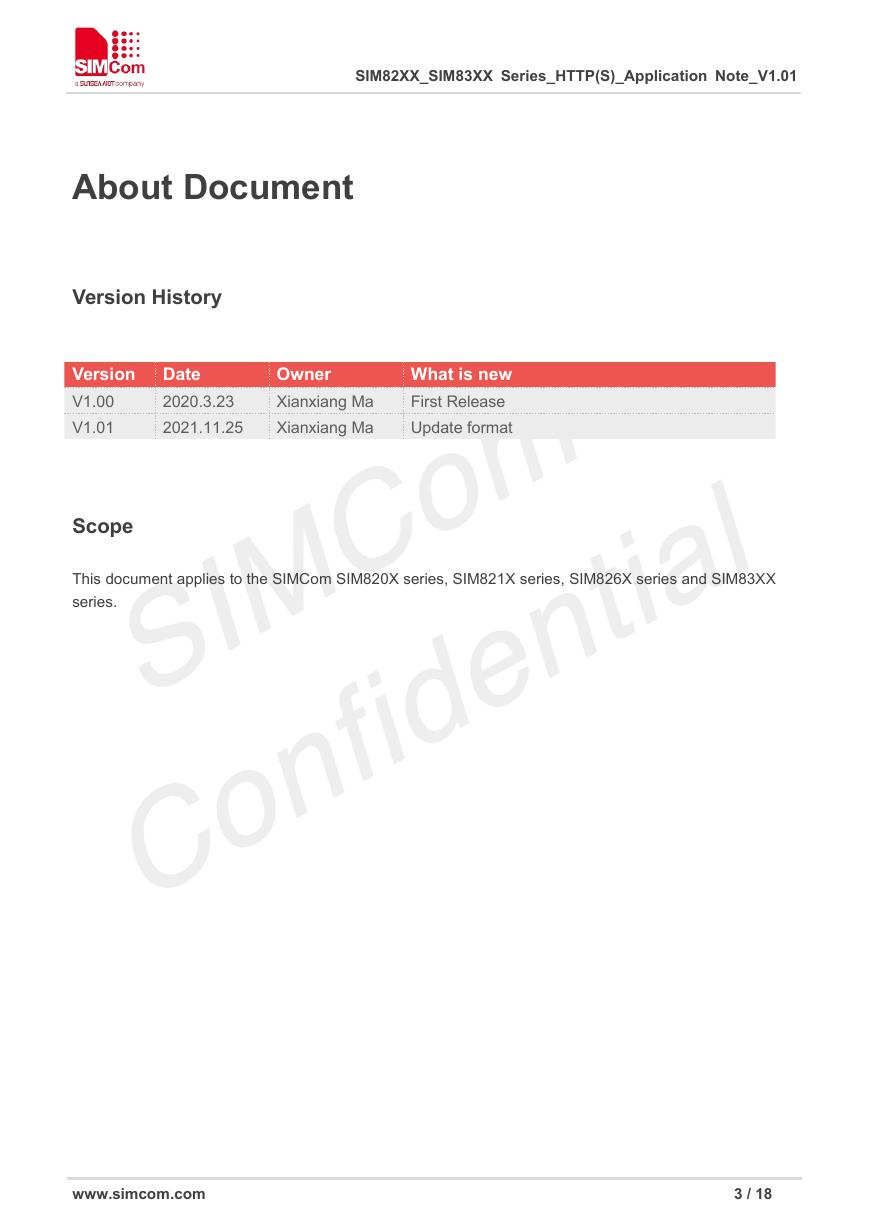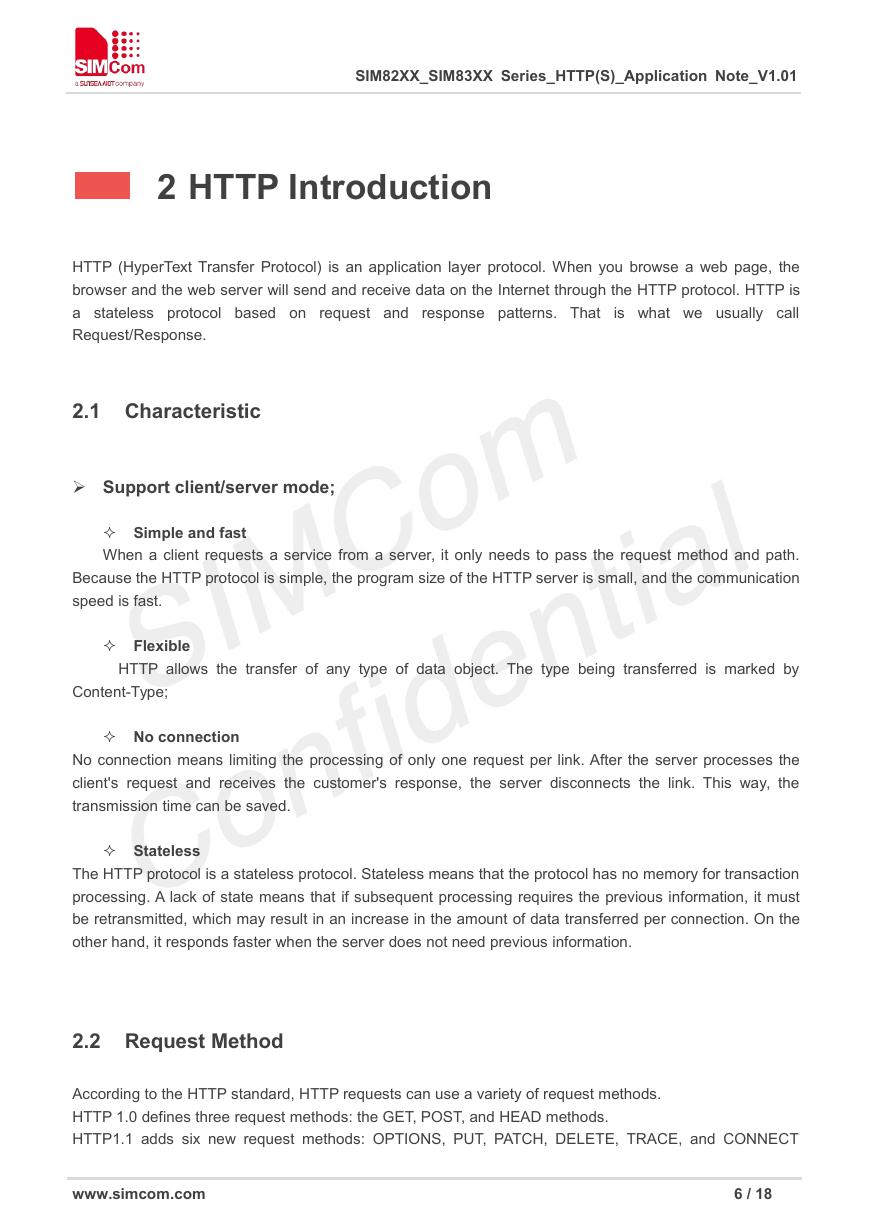SIM82XX_SIM83XX Series
_HTTP(S)_Application Note
5G Module
SIMCom Wireless Solutions Limited
SIMCom Headquarters Building, Building 3, No. 289
Linhong Road, Changning District, Shanghai P.R. China
Tel: 86-21-31575100
support@simcom.com
www.simcom.com
�
SIM82XX_SIM83XX Series_HTTP(S)_Application Note_V1.01
Document Title::
Version:
Date:
Status:
GENERAL NOTES
SIM82XX_SIM83XX Series_HTTP(S)_Application Note
1.01
2021.11.25
Released
SIMCOM OFFERS THIS INFORMATION AS A SERVICE TO ITS CUSTOMERS, TO SUPPORT
APPLICATION AND ENGINEERING EFFORTS THAT USE THE PRODUCTS DESIGNED BY SIMCOM.
THE INFORMATION PROVIDED IS BASED UPON REQUIREMENTS SPECIFICALLY PROVIDED TO
SIMCOM BY THE CUSTOMERS. SIMCOM HAS NOT UNDERTAKEN ANY INDEPENDENT SEARCH
FOR ADDITIONAL RELEVANT INFORMATION, INCLUDING ANY INFORMATION THAT MAY BE IN THE
CUSTOMER’S POSSESSION. FURTHERMORE, SYSTEM VALIDATION OF THIS PRODUCT
DESIGNED BY SIMCOM WITHIN A LARGER ELECTRONIC SYSTEM REMAINS THE RESPONSIBILITY
OF THE CUSTOMER OR THE CUSTOMER’S SYSTEM INTEGRATOR. ALL SPECIFICATIONS
SUPPLIED HEREIN ARE SUBJECT TO CHANGE.
COPYRIGHT
THIS DOCUMENT CONTAINS PROPRIETARY TECHNICAL INFORMATION WHICH IS THE PROPERTY
OF SIMCOM WIRELESS SOLUTIONS LIMITED COPYING, TO OTHERS AND USING THIS DOCUMENT,
ARE FORBIDDEN WITHOUT EXPRESS AUTHORITY BY SIMCOM. OFFENDERS ARE LIABLE TO THE
PAYMENT OF INDEMNIFICATIONS. ALL RIGHTS RESERVED BY SIMCOM IN THE PROPRIETARY
TECHNICAL INFORMATION, INCLUDING BUT NOT LIMITED TO REGISTRATION GRANTING OF A
PATENT , A UTILITY MODEL OR DESIGN. ALL SPECIFICATION SUPPLIED HEREIN ARE SUBJECT TO
CHANGE WITHOUT NOTICE AT ANY TIME.
SIMCom Wireless Solutions Limited
SIMCom Headquarters Building, Building 3, No. 289 Linhong Road, Changning District, Shanghai P.R.
China
Tel: +86 21 31575100
Email: simcom@simcom.com
For more information, please visit:
https://www.simcom.com/download/list-863-en.html
For technical support, or to report documentation errors, please visit:
https://www.simcom.com/ask/ or email to: support@simcom.com
Copyright © 2021 SIMCom Wireless Solutions Limited All Rights Reserved.
www.simcom.com
2 / 18
�
SIM82XX_SIM83XX Series_HTTP(S)_Application Note_V1.01
About Document
Version History
Version
V1.00
V1.01
Date
2020.3.23
2021.11.25
Owner
Xianxiang Ma
Xianxiang Ma
What is new
First Release
Update format
Scope
This document applies to the SIMCom SIM820X series, SIM821X series, SIM826X series and SIM83XX
series.
www.simcom.com
3 / 18
�
SIM82XX_SIM83XX Series_HTTP(S)_Application Note_V1.01
Contents
About Document............................................................................................................ 3
Version History.........................................................................................................................................................3
Scope........................................................................................................................................................................ 3
Contents........................................................................................................................... 4
1 Introduction............................................................................................................... 5
Purpose of the document...........................................................................................................................5
Related documents.....................................................................................................................................5
Conventions and abbreviations................................................................................................................ 5
1.1
1.2
1.3
2 HTTP Introduction....................................................................................................6
Characteristic...............................................................................................................................................6
Request Method.......................................................................................................................................... 6
2.1
2.2
3 AT Commands for HTTP(S)...................................................................................8
4 Bearer Configuration.............................................................................................. 9
4.1 PDN Auto-activation.........................................................................................................................................9
5.1
5.2
5.1.1
5.1.2
5.1.3
5 HTTP(S) Examples.................................................................................................11
HTTP Function...........................................................................................................................................11
HTTP GET......................................................................................................................................11
Send HTTP POST Request........................................................................................................ 12
Send HTTP HEAD Request........................................................................................................13
Access to HTTPS server......................................................................................................................... 14
Send HTTPS GET Request........................................................................................................14
Send HTTPS POST Request..................................................................................................... 15
Send HTTPS HEAD Request.....................................................................................................16
POST FILE to HTTPS server and read HTTPS response content to a file........................17
5.2.1
5.2.2
5.2.3
5.2.4
www.simcom.com
4 / 18
�
SIM82XX_SIM83XX Series_HTTP(S)_Application Note_V1.01
1 Introduction
1.1 Purpose of the document
Based on module AT command manual, this document will introduce HTTP(S) application process.
Developers could understand and develop application quickly and efficiently based on this document.
1.2 Related documents
[1] SIM82XX_SIM83XX Series_AT Command Manual
1.3 Conventions and abbreviations
In this document, the GSM engines are referred to as following term:
ME (Mobile Equipment);
MS (Mobile Station);
TA (Terminal Adapter);
DCE (Data Communication Equipment) or facsimile DCE (FAX modem, FAX board);
In application, controlling device controls the GSM engine by sending AT Command via its serial interface.
The controlling device at the other end of the serial line is referred to as following term:
TE (Terminal Equipment);
DTE (Data Terminal Equipment) or plainly "the application" which is running on an embedded system;
www.simcom.com
5 / 18
�
SIM82XX_SIM83XX Series_HTTP(S)_Application Note_V1.01
2 HTTP Introduction
HTTP (HyperText Transfer Protocol) is an application layer protocol. When you browse a web page, the
browser and the web server will send and receive data on the Internet through the HTTP protocol. HTTP is
a stateless protocol based on request and response patterns. That
is what we usually call
Request/Response.
2.1 Characteristic
Support client/server mode;
Simple and fast
When a client requests a service from a server, it only needs to pass the request method and path.
Because the HTTP protocol is simple, the program size of the HTTP server is small, and the communication
speed is fast.
Flexible
HTTP allows the transfer of any type of data object. The type being transferred is marked by
Content-Type;
No connection
No connection means limiting the processing of only one request per link. After the server processes the
client's request and receives the customer's response, the server disconnects the link. This way, the
transmission time can be saved.
Stateless
The HTTP protocol is a stateless protocol. Stateless means that the protocol has no memory for transaction
processing. A lack of state means that if subsequent processing requires the previous information, it must
be retransmitted, which may result in an increase in the amount of data transferred per connection. On the
other hand, it responds faster when the server does not need previous information.
2.2 Request Method
According to the HTTP standard, HTTP requests can use a variety of request methods.
HTTP 1.0 defines three request methods: the GET, POST, and HEAD methods.
HTTP1.1 adds six new request methods: OPTIONS, PUT, PATCH, DELETE, TRACE, and CONNECT
www.simcom.com
6 / 18
�
SIM82XX_SIM83XX Series_HTTP(S)_Application Note_V1.01
methods.
No Method
1
GET
2
3
4
5
6
7
8
9
HEAD
POST
PUT
DELETE
CONNECT
OPTIONS
TRACE
PATCH
Description
Make a request to a specific resource.
Ask the server for a response that is consistent with the GET request, except
that the response body will not be returned. This method can obtain the meta
information contained in the response message header without having to
transmit the entire response content.
Submit data to a specified resource for processing requests (such as submitting
a form or uploading a file). The data is included in the request body. POST
requests may result in the creation of new resources and/or modifications to
existing resources.
Uploads its latest content to a specified resource location.
Requests the server to delete the resource identified by the Request-URI.
H The HTTP/1.1 protocol
connections to pipes.
Returns the HTTP request method supported by the server for a particular
resource. You can also test the functionality of the server by sending a '*'
request to the web server.
Echoes requests received by the server, primarily for testing or diagnostics.
It is a supplement to the PUT method for local updating of known resources.
is reserved for proxy servers that can connect
The SIM8200 series supports several methods: GET, POST and HEAD.
www.simcom.com
7 / 18
�
SIM82XX_SIM83XX Series_HTTP(S)_Application Note_V1.01
3 AT Commands for HTTP(S)
Command
AT+HTTPPARA
AT+HTTPINIT
AT+HTTPACTION
AT+HTTPHEAD
AT+HTTPREAD
AT+HTTPDATA
AT+HTTPPOSTFILE
AT+HTTPREADFILE
AT+HTTPTERM
DESCRIPTION
Set HTTP(S) Parameter
Start HTTP(S) service
HTTP(S) Method Action
Read the HTTP Header Information of Server Response
Read the response Information of Server Response
You can use AT+HTTPDATA to input data to post when you send a
HTTP/HTTPS POST request
Send HTTP request in a file via AT+HTTPPOSTFILE command
Receive HTTP Response Content to a file
Stop HTTP service.
For detail information, please refer to " SIM82XX_SIM83XX_Series_AT Command Manual".
www.simcom.com
8 / 18
�
















 V2版本原理图(Capacitive-Fingerprint-Reader-Schematic_V2).pdf
V2版本原理图(Capacitive-Fingerprint-Reader-Schematic_V2).pdf 摄像头工作原理.doc
摄像头工作原理.doc VL53L0X简要说明(En.FLVL53L00216).pdf
VL53L0X简要说明(En.FLVL53L00216).pdf 原理图(DVK720-Schematic).pdf
原理图(DVK720-Schematic).pdf 原理图(Pico-Clock-Green-Schdoc).pdf
原理图(Pico-Clock-Green-Schdoc).pdf 原理图(RS485-CAN-HAT-B-schematic).pdf
原理图(RS485-CAN-HAT-B-schematic).pdf File:SIM7500_SIM7600_SIM7800 Series_SSL_Application Note_V2.00.pdf
File:SIM7500_SIM7600_SIM7800 Series_SSL_Application Note_V2.00.pdf ADS1263(Ads1262).pdf
ADS1263(Ads1262).pdf 原理图(Open429Z-D-Schematic).pdf
原理图(Open429Z-D-Schematic).pdf 用户手册(Capacitive_Fingerprint_Reader_User_Manual_CN).pdf
用户手册(Capacitive_Fingerprint_Reader_User_Manual_CN).pdf CY7C68013A(英文版)(CY7C68013A).pdf
CY7C68013A(英文版)(CY7C68013A).pdf TechnicalReference_Dem.pdf
TechnicalReference_Dem.pdf